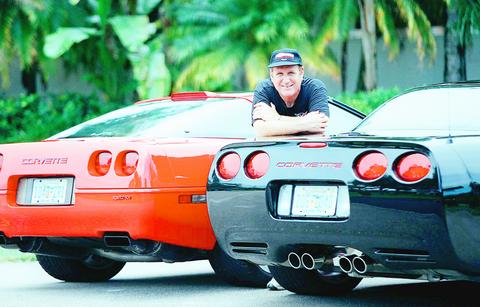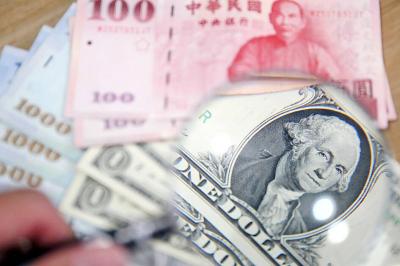In the small subset of automobiles that can properly be called American sports cars, the undisputed king is the Corvette.
The original two-seater Thunderbird, which had a good run but wasn't made after 1957, was not really a sports car; today's successor isn't either. The Dodge Viper, a challenger since 1991, has not reached Corvette-level appeal or sales. The AC Cobra, now a beloved collectors' car, flashed in and flamed out in the 1960s. The Corvette endures -- 32,000 made every year, 32,000 sold every year. Those who love the Corvette love it fanatically.

PHOTO: NY TIMES
To Martin A. Drutz, a Miami accountant who has owned a dozen Corvettes and has an office full of Corvette memorabilia, it is the sine qua non: "To me, there is no other car."
The Corvette touched America's yearning for excitement and glamour as perhaps no other car ever did. Martin Milner and George Maharis sped to adventure in a Corvette on Route 66. A Corvette entered James Bond's life in A View to a Kill. William Shatner, still the youthful Captain Kirk, proudly posed in his, and Alan Shepard, who really did fly in space, was just one of several astronauts who drove them. The Corvette spoke of power, speed and Marilyn Monroe look-alikes, usually in the passenger seat.
As a boy growing up in the 1950s and 1960s, Drutz, now 54, spent hours gluing model Corvettes together. Like millions of other boys and young men (85 percent of Corvette owners are male, according to Chevrolet), he dreamed of the day when he would own one, and like many others, he made his dream come true. But it might be hard to find a boy with that dream today.
This year the Corvette turns 50, and many of its fans have reached that milestone before it. According to Chevrolet, 49 percent of new Corvette buyers are over 50, and 76 percent are over 40. Only 7 percent are 30 and under.
George Kerbeck, an owner of Kerbeck Chevrolet in Atlantic City, one of the largest Corvette dealers in the country, said most of his customers were between 48 and 52.
Other Corvette sellers cater to a similar market. "A guy came in here yesterday saying, `I got my kids in college, all my expenses are over and done with, now I want my Corvette,'" Bob Baker of Corvette Mike New England in Plymouth, Massachusetts, said Wednesday.
Price is a factor, of course. ("What kid has 50 grand?" as Baker put it.) But David Glaze, vice president and creative director at Genex, an Internet consulting company in Los Angeles, said people in their 20s and 30s who have money to spend and like what he calls "racer cars" want smaller, sleeker cars, not automobiles they associate with, say, Robert Novak, the 71-year-old political commentator who is repeatedly teased on CNN's Crossfire about his new black Corvette.
"A Corvette?" said Jennifer Thompson, 30, an art director in New York. "Aren't they for guys in gold chains who are trying to recapture their youth?"
Stalking generations X and Y
Glaze said Chevrolet would have to work hard to reignite interest in the brand with young people. Based on his research as a designer of automobile Web sites (Corvette's 50th anniversary site is among them), he said that the racer cars that appeal to the youth market are "little star-fighter things, the small Audis, the Acura Integra and the Honda Si."
Jamie McDonald, a 32-year-old producer at Fox News in New York, called the Corvette passe. He aspires to own a Porsche 911 -- "That's a car," he said reverently.
Generations X and Y may not think so, but the Corvette is very much a car. It has a top speed of 275kph, and it's reasonably comfortable and practical. Its V8 engine achieves a remarkable combination of performance and fuel economy -- this is a racer car that gets nearly 48km a gallon on the highway. And its low-slung shape is unmistakable.
"I've driven other sports cars -- Porsche 911's and Panteras, for instance -- and they're all fun in their unique way," said Kevin Wanner, 40, a manager at America Online in South Orange, New Jersey, who takes his 1996 LT4 to amateur competitions. "But the Corvette seems to have limitless power, great adhesion and is very forgiving."
Arnie Tanowitz, 50, the chief executive of the Rutan Polyethylene Supply and Bag Manufacturing Co in Mahwah, New Jersey, expresses his enthusiasm for his Corvette more lyrically. "Have you ever listened to a throaty V8 with a dual exhaust up Route 9W, over the Bear Mountain Bridge and up Route 9 with some great music and the roof off?" he said. "Do you know the difference between driving a car and being driven by a car?"
General Motors has produced more than 1.4 million Corvettes since its chief stylist, Harley Earl, decided in 1951 to design a new American sports car. In January 1953, the prototype went on display at the Motorama show at the Waldorf-Astoria, and production began that June in Flint, Mich. From the beginning, the Corvette catered to a highly selective, wealthy audience, and production was deliberately limited. "When you overbuild," said Bob Tripolsky, the communications manager at Chevrolet, there is a "likelihood of reducing the mystique of the cars."When the Corvette first rolled into showrooms, Americans were bursting with postwar pride. As the Corvette reaches its 50th anniversary -- the 2003 model is already in some showrooms -- many Americans are once again full of patriotic resolve. More than anyone might have expected a year ago, a celebration of the Corvette, an icon of American design and engineering and a hardy competitor in a field dominated by foreign models, has turned out to be in step with the times.
Besides being quintessentially American, the Corvette has the democratic quality of being more broadly affordable than most sports cars. The Porsche 911 costs US$70,000 to US$120,000; the Ferrari 575M Maranello is close to US$250,000. The most expensive new Corvette today is the Z06, at just over US$51,000; the cheapest is the coupe, at US$42,350.
Down in Nashville
Corvette is celebrating its 50th year with a range of promotions. The most notable is planned for June in Nashville, featuring caravans, displays, concerts, exhibitions, engineering talks and thousands of Corvettes.
In any year, there is no shortage of outlets for the Corvette-obsessed: Corvette clubs, Corvette competitions and meets, and Corvette magazines. This year's Corvette Celebration at the National Corvette Museum, in Bowling Green, Kentucky, on Labor Day will be the eighth annual such event. Corvette owners can also indulge themselves with myriad collectibles -- model cars, decanters, knives, lighters, plates and, of course, multiple Corvettes, new and old.
A good 1957 model now goes for US$50,000; it cost US$3,000 new.
Executives at General Motors speak bravely of attracting a wider market. Rick Baldick, the director of marketing for Corvette in Detroit, said the company was targeting younger buyers. Marketing for the 2003 Corvette will include ads in magazines like Golf, Men's Journal and MBA Jungle aimed at the "dreamer" category -- the youngish man aspiring to own an exciting car.
Whether younger buyers discover the Corvette or not, Chevrolet doesn't foresee any imminent decline in Corvette sales. Tripolsky, the Chevrolet spokesman, says he is confident that Corvettes will be produced for a very long time. And certainly its baby boomer fans have time to buy many more.
Jay Leno, 52, the host of The Tonight Show, owns two Corvettes, a 1999 and a 2002. He also has 80 other cars, mostly antiques, and 80 motorcycles; he keeps them in a warehouse, but he actually drives his Corvettes.
Leno said the special quality of the Corvette -- what he calls "an attainable lure" -- by comparing it to the actress Sandra Bullock. "She's a beautiful movie star," he said in a telephone interview from his office in Los Angeles, "and she seems like a regular girl." That, he said, is what the Corvette is like. It "just does everything right -- it can be glamorous or a car you can park at the market."
But if he can see taking one of his Corvettes to the grocery store, he would never dream of driving them to Hollywood parties. "You'd have to be an idiot to leave them with a valet," he said. "I take my banged-up '91 Syclone truck."

The US dollar was trading at NT$29.7 at 10am today on the Taipei Foreign Exchange, as the New Taiwan dollar gained NT$1.364 from the previous close last week. The NT dollar continued to rise today, after surging 3.07 percent on Friday. After opening at NT$30.91, the NT dollar gained more than NT$1 in just 15 minutes, briefly passing the NT$30 mark. Before the US Department of the Treasury's semi-annual currency report came out, expectations that the NT dollar would keep rising were already building. The NT dollar on Friday closed at NT$31.064, up by NT$0.953 — a 3.07 percent single-day gain. Today,

‘SHORT TERM’: The local currency would likely remain strong in the near term, driven by anticipated US trade pressure, capital inflows and expectations of a US Fed rate cut The US dollar is expected to fall below NT$30 in the near term, as traders anticipate increased pressure from Washington for Taiwan to allow the New Taiwan dollar to appreciate, Cathay United Bank (國泰世華銀行) chief economist Lin Chi-chao (林啟超) said. Following a sharp drop in the greenback against the NT dollar on Friday, Lin told the Central News Agency that the local currency is likely to remain strong in the short term, driven in part by market psychology surrounding anticipated US policy pressure. On Friday, the US dollar fell NT$0.953, or 3.07 percent, closing at NT$31.064 — its lowest level since Jan.

The New Taiwan dollar and Taiwanese stocks surged on signs that trade tensions between the world’s top two economies might start easing and as US tech earnings boosted the outlook of the nation’s semiconductor exports. The NT dollar strengthened as much as 3.8 percent versus the US dollar to 30.815, the biggest intraday gain since January 2011, closing at NT$31.064. The benchmark TAIEX jumped 2.73 percent to outperform the region’s equity gauges. Outlook for global trade improved after China said it is assessing possible trade talks with the US, providing a boost for the nation’s currency and shares. As the NT dollar

The Financial Supervisory Commission (FSC) yesterday met with some of the nation’s largest insurance companies as a skyrocketing New Taiwan dollar piles pressure on their hundreds of billions of dollars in US bond investments. The commission has asked some life insurance firms, among the biggest Asian holders of US debt, to discuss how the rapidly strengthening NT dollar has impacted their operations, people familiar with the matter said. The meeting took place as the NT dollar jumped as much as 5 percent yesterday, its biggest intraday gain in more than three decades. The local currency surged as exporters rushed to